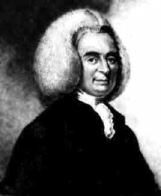

Colin Maclaurin's parents died when he was young, so he and his brother were brought up by an uncle who was a minister. He became a student at the University of Glasgow in 1709 at the age of 11. This may seem young for someone to begin their university education, but it was not so unusual at this time.
His first encounter with advanced mathematics came one year after he entered
university, when he found a copy of Euclid's Elements in one of his friend's rooms. This was the standard text for mathematical study at this time, but
Maclaurin studied it on his own, quickly mastering the first 6 of the 13 books. At Glasgow Maclaurin came into contact with Simson who was the Professor of Mathematics there. Simson was particularly interested in the geometry of ancient Greece and his enthusiasm for the
topic was to influence the young student Maclaurin.
At the age of 14 Maclaurin was awarded a degree. He had to
defend a thesis in a public examination, and he chose "On the power of gravity" as his topic. The
thesis, which developed Newton's theories, was written by a 14 year old boy at a time when such advanced ideas would only be familiar to a small number of the leading mathematicians.
After graduating, he remained at the University of Glasgow for a further year to study divinity. It had been his intention to enter the Presbyterian Church, but he decide against this.
He was soon appointed professor of mathematics at Marischal College in the University of Aberdeen.
Maclaurin travelled to London to meet Newton, and was elected a Fellow of the Royal Society during this visit. He also travelled France, meeting with many French mathematicians.
While there, he was awarded a Grand Prize by the Academy of Sciences in Paris for his work on the impact of bodies.
In 1725, Maclaurin sought and got a position in the University of Edinburgh, where he was to spend the rest of his career. In 1733 he married the daughter of the Solicitor General for Scotland. Not
long after his marriage, Maclaurin worked to expand the Medical Society of Edinburgh into a wider society to include other branches of learning. Maclaurin
himself acted as one of the two secretaries of this expanded Society and at the monthly meetings he often read a paper of his own or a letter from a foreign
scientist on the latest developments in some topic of current interest. This Society would, after Maclaurin's death, become the Royal Society of Edinburgh.
Maclaurin did notable work in geometry, particularly studying higher plane curves. In 1740, he was awarded a second prize from the Academy of Sciences in Paris, this time for a study of the
tides. This prize was jointly awarded to Maclaurin, Euler and Daniel Bernoulli, bracketing Maclaurin with the top two mathematicians of his day.
In 1742, Maclaurin published his 2 volume Treatise of fluxions, the first systematic exposition of Newton's methods. This was a major work of 763 pages, much praised by those who read it but usually described as having little influence. The most important deatures were
his treatment of the fundamental theorem of the calculus, his work on maxima and minima, the attraction of ellipsoids, elliptic integrals, and the
Euler-Maclaurin summation formula.
Maclaurin appealed to the geometrical methods of the ancient Greeks and to Archimedes' method of exhaustion in attempting to put Newton's calculus on a
rigorous footing. It is in the Treatise of fluxions that Maclaurin uses the special case of Taylor's series now named after him and for which he is undoubtedly
best remembered today. Another important result given by Maclaurin, which has not been named after him or any other mathematician, is the important integral
test for the convergence of an infinite series. He also
gave many applications of calculus in the work.
Other topics which Maclaurin wrote on were the annular eclipse of the sun in 1737 and the structure of bees' honeycombs. He also contributed to actuarial
studies as one of the founders of the topic. He was also said to be a very good teacher.
Maclaurin's Treatise on algebra was published 2 years after his death. Another work Account of Sir Isaac Newton's discoveries was left
incomplete on his death, but was published in 1750.